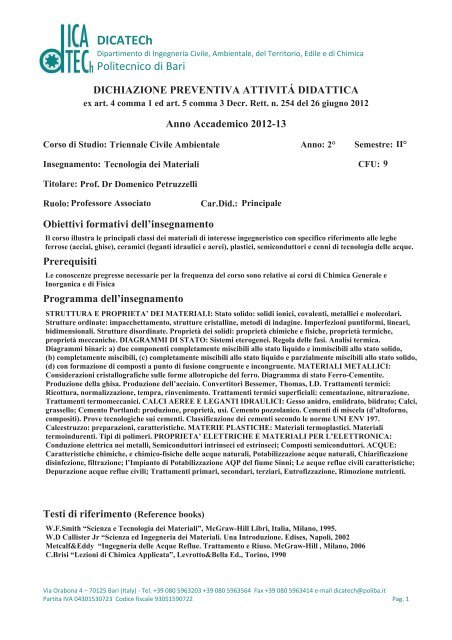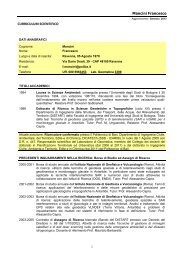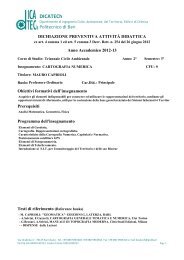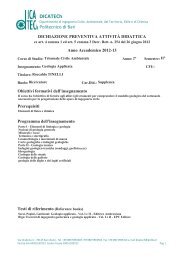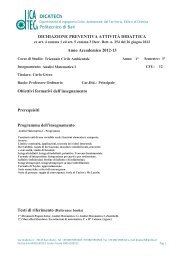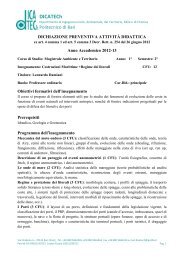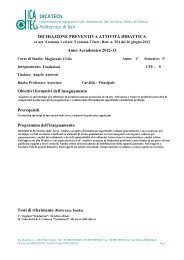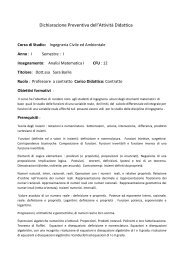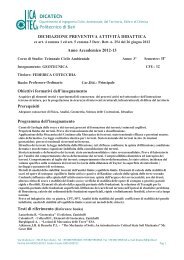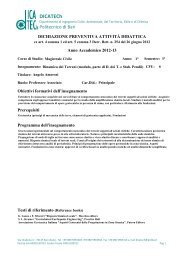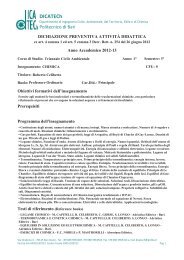Tecnologia dei Materiali.pdf - DICATECh - Politecnico di Bari
Tecnologia dei Materiali.pdf - DICATECh - Politecnico di Bari
Tecnologia dei Materiali.pdf - DICATECh - Politecnico di Bari
You also want an ePaper? Increase the reach of your titles
YUMPU automatically turns print PDFs into web optimized ePapers that Google loves.
<strong>DICATECh</strong><br />
Dipartimento<strong>di</strong>IngegneriaCivile,Ambientale,delTerritorio,E<strong>di</strong>lee<strong>di</strong>Chimica<br />
<strong>Politecnico</strong><strong>di</strong><strong>Bari</strong><br />
DICHIAZIONE PREVENTIVA ATTIVITÁ DIDATTICA<br />
ex art. 4 comma 1 ed art. 5 comma 3 Decr. Rett. n. 254 del 26 giugno 2012<br />
Anno Accademico 2012-13<br />
Corso <strong>di</strong> Stu<strong>di</strong>o: Triennale Civile Ambientale Anno: 2° Semestre: II°<br />
Insegnamento:<br />
<strong>Tecnologia</strong> <strong>dei</strong> <strong>Materiali</strong> CFU: 9<br />
Titolare: Prof. Dr Domenico Petruzzelli<br />
Ruolo: Professore Associato<br />
Car.Did.:<br />
Principale<br />
Obiettivi formativi dell’insegnamento<br />
Il corso illustra le principali classi <strong>dei</strong> materiali <strong>di</strong> interesse ingegneristico con specifico riferimento alle leghe<br />
ferrose (acciai, ghise), ceramici (leganti idraulici e aerei), plastici, semiconduttori e cenni <strong>di</strong> tecnologia delle acque.<br />
Prerequisiti<br />
Le conoscenze pregresse necessarie per la frequenza del corso sono relative ai corsi <strong>di</strong> Chimica Generale e<br />
Inorganica e <strong>di</strong> Fisica<br />
Programma dell’insegnamento<br />
STRUTTURA E PROPRIETA’ DEI MATERIALI: Stato solido: soli<strong>di</strong> ionici, covalenti, metallici e molecolari.<br />
Strutture or<strong>di</strong>nate: impacchettamento, strutture cristalline, meto<strong>di</strong> <strong>di</strong> indagine. Imperfezioni puntiformi, lineari,<br />
bi<strong>di</strong>mensionali. Strutture <strong>di</strong>sor<strong>di</strong>nate. Proprietà <strong>dei</strong> soli<strong>di</strong>: proprietà chimiche e fisiche, proprietà termiche,<br />
proprietà meccaniche. DIAGRAMMI DI STATO: Sistemi eterogenei. Regola delle fasi. Analisi termica.<br />
Diagrammi binari: a) due componenti completamente miscibili allo stato liquido e immiscibili allo stato solido,<br />
(b) completamente miscibili, (c) completamente miscibili allo stato liquido e parzialmente miscibili allo stato solido,<br />
(d) con formazione <strong>di</strong> composti a punto <strong>di</strong> fusione congruente e incongruente. MATERIALI METALLICI:<br />
Considerazioni cristallografiche sulle forme allotropiche del ferro. Diagramma <strong>di</strong> stato Ferro-Cementite.<br />
Produzione della ghisa. Produzione dell’acciaio. Convertitori Bessemer, Thomas, LD. Trattamenti termici:<br />
Ricottura, normalizzazione, tempra, rinvenimento. Trattamenti termici superficiali: cementazione, nitrurazione.<br />
Trattamenti termomeccanici. CALCI AEREE E LEGANTI IDRAULICI: Gesso anidro, emiidrato, biidrato; Calci,<br />
grassello; Cemento Portland: produzione, proprietà, usi. Cemento pozzolanico. Cementi <strong>di</strong> miscela (d’altoforno,<br />
compositi). Prove tecnologiche sui cementi. Classificazione <strong>dei</strong> cementi secondo le norme UNI ENV 197.<br />
Calcestruzzo: preparazioni, caratteristiche. MATERIE PLASTICHE: <strong>Materiali</strong> termoplastici. <strong>Materiali</strong><br />
termoindurenti. Tipi <strong>di</strong> polimeri. PROPRIETA’ ELETTRICHE E MATERIALI PER L’ELETTRONICA:<br />
Conduzione elettrica nei metalli, Semiconduttori intrinseci ed estrinseci; Composti semiconduttori. ACQUE:<br />
Caratteristiche chimiche, e chimico-fisiche delle acque naturali, Potabilizzazione acque naturali, Chiarificazione<br />
<strong>di</strong>sinfezione, filtrazione; l’Impianto <strong>di</strong> Potabilizzazione AQP del fiume Sinni; Le acque reflue civili caratteristiche;<br />
Depurazione acque reflue civili; Trattamenti primari, secondari, terziari, Eutrofizzazione, Rimozione nutrienti.<br />
Testi <strong>di</strong> riferimento (Reference books)<br />
W.F.Smith “Scienza e <strong>Tecnologia</strong> <strong>dei</strong> <strong>Materiali</strong>”, McGraw-Hill Libri, Italia, Milano, 1995.<br />
W.D Callister Jr “Scienza ed Ingegneria <strong>dei</strong> <strong>Materiali</strong>. Una Introduzione. E<strong>di</strong>ses, Napoli, 2002<br />
Metcalf&Eddy “Ingegneria delle Acque Reflue. Trattamento e Riuso. McGraw-Hill , Milano, 2006<br />
C.Brisi “Lezioni <strong>di</strong> Chimica Applicata”, Levrotto&Bella Ed., Torino, 1990<br />
ViaOrabona4–70125<strong>Bari</strong>(Italy)Tel.+390805963203+390805963564Fax+390805963414email<strong>di</strong>catech@poliba.it<br />
PartitaIVA04301530723Co<strong>di</strong>cefiscale93051590722 Pag.1
<strong>DICATECh</strong><br />
Dipartimento<strong>di</strong>IngegneriaCivile,Ambientale,delTerritorio,E<strong>di</strong>lee<strong>di</strong>Chimica<br />
<strong>Politecnico</strong><strong>di</strong><strong>Bari</strong><br />
Modalità <strong>di</strong> svolgimento degli esami (Examination procedures)<br />
L'esame si svolge me<strong>di</strong>ante verifiche perio<strong>di</strong>che scritte con eventuale prova orale finale in caso<br />
<strong>di</strong> insufficienza degli esoneri svolti in corso d'anno<br />
Diario degli Esami anno 2013 (Examination dates year 2013)<br />
Gennaio 16 ore 09.30 Febbraio 13 ore 09.30<br />
Aprile 17 ore 09.30 Giugno 12 ore 09.30<br />
Luglio 17 ore 09.30 Settembre 18 ore 09.30<br />
Ottobre 16 ore 09.30 Novembre 13 ore 09.30<br />
Luogo degli esami (Examinations place):<br />
Laboratorio <strong>di</strong> Chimica Ambientale, Centro Inter<strong>di</strong>partimenta<br />
Commissione <strong>di</strong> esame anno 2013 (Examinations board year 2013)<br />
Presidente:<br />
Prof. Dr Domenico Petruzzelli<br />
Componente: Prof.Dr Andrea Petrella<br />
Supplente: Prof.Dr Roberto Celiberto<br />
Componente: Prof.Ing.Maurizio Notarnicola<br />
Supplente: Prof.Dr Giancarlo Boghetich<br />
Ricevimento studenti (Students reception)<br />
giorno (day): mercoledì ora (time): 09.30<br />
luogo (place): Stanza <strong>di</strong> Pertinenza, Taranto<br />
Note:<br />
Il Prof. Petruzzelli fornisce delucidazioni relative agli argomenti del corso in qualsiasi momento me<strong>di</strong>ante contatto<br />
all'in<strong>di</strong>rizzo <strong>di</strong> posta elettronica: d.petruzzelli@poliba.it<br />
ViaOrabona4–70125<strong>Bari</strong>(Italy)Tel.+390805963203+390805963564Fax+390805963414email<strong>di</strong>catech@poliba.it<br />
PartitaIVA04301530723Co<strong>di</strong>cefiscale93051590722 Pag.2
<strong>DICATECh</strong><br />
Dipartimento<strong>di</strong>IngegneriaCivile,Ambientale,delTerritorio,E<strong>di</strong>lee<strong>di</strong>Chimica<br />
<strong>Politecnico</strong><strong>di</strong><strong>Bari</strong><br />
Study course informations (english)<br />
Study course: Materials Science and Technology CFU: 9<br />
Professor:<br />
Prof. Dr Domenico Petruzzelli<br />
Course Target:<br />
Lectures give a general overview of main classes of materials for engineering applications, with specific reference to<br />
ferrous alloys (steel, cast iron) ceramics (cement, cement conglomerates, mortars), plastic materials,<br />
semiconductors, Water and wastewater technology.<br />
Required knowledge:<br />
Basic knowledge in General and Inorganic Chemistry and Physics is required.<br />
Course Program:<br />
MOLECULAR STRUCTURE OF MATERIALS AND PROPERTIES Solid state: ionic solids, covalent, metallic<br />
and molecular. Ordered structures: packings, cristalline structures, experimental methods. Imperfections: (point,<br />
linear, bi<strong>di</strong>mensional. Disordered structures. Properties of solids: chemical and physical, thermal properties,<br />
mechanical properties. STATE DIAGRAMS: Heterogeneous systems. Phase rule. Thermal analysis. Binary<br />
<strong>di</strong>agrams: a) complete miscibility (liquid and solid); b) two components: liquid miscible and solid unmiscible, , c)<br />
partial miscibility at solid state; d) formation of binary compounds with congruent and uncongruent melting point.<br />
STEEL SIDERURGY: Cristallinity and allotropy of iron. Fe/Fe3C state <strong>di</strong>agram. Cast iron production. Steel<br />
production. Bessemer/Thomas/ LD steel converters. Thermal treatments of steel: Cooking, normalization, temper,<br />
reviving. Surface thermal treatment: cementation, nitrogen inclusion. Thermomechanical treatments. AIR AND<br />
HYDRAULIC LIGANDS Dry gypsum, hemihydrate, <strong>di</strong>hydrate; Lime, Portland cement: production, properties,<br />
uses. Pozzolanic cement. Mixed Cement (altoforno, alluminous, for dams). Technical tests on cements. Classes of<br />
cements (UNI ENV 197). Concrete: preparation, behaviour. PLASTICS: Synthesis. Thermoplastic materials.<br />
Thermal hardening materials. Classes of polymers. ELECTRIC PROPERTIES AND MATERIALS FOR<br />
ELECTRONICS: Electric conductivity, Semiconductors (intrinsic and estrinsic); p-n junctions. Microelectronics.<br />
WATER AND WASTEWATER TECHNOLOGY: Drinking water treatment; Wastewater treatment.<br />
Il Titolare dell’Insegnamento<br />
_________________________<br />
(firma)<br />
(Spe<strong>di</strong>re con urgenza in posta elettronica all’in<strong>di</strong>rizzo a.volpicella@poliba.it e successivamente consegnare firmato,<br />
entro e non oltre il 10 <strong>di</strong>cembre p.v., al Responsabile del Settore Didattica (Sig.ra Annalisa Volpicella))<br />
ViaOrabona4–70125<strong>Bari</strong>(Italy)Tel.+390805963203+390805963564Fax+390805963414email<strong>di</strong>catech@poliba.it<br />
PartitaIVA04301530723Co<strong>di</strong>cefiscale93051590722 Pag.3


